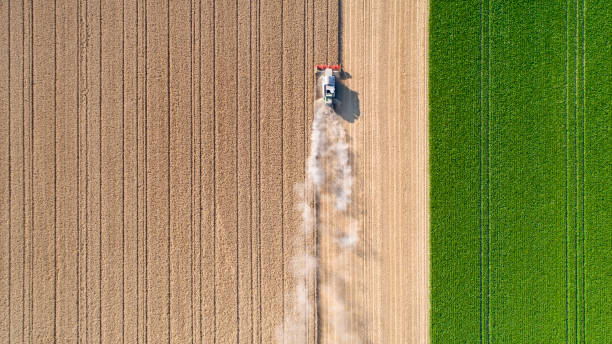As the global population continues to grow at an unprecedented rate, the demand for food production is increasing daily. Farmers are turning to innovative precision agriculture technologies to meet these demands to improve production efficiency and sustainability. One such technology that has the potential to revolutionize farming activities is the tractor auto steer system. The advantages of the tractor auto steer systems extend beyond general farming practices and into the critical harvest season. In this blog post, we will explore the significant changes brought about by the auto steer systems for tractors during the harvest season and the profound impact of this precision agriculture technology on agricultural production and farmers' lives.

1. Improved Harvesting Efficiency
During the harvest season, time is incredibly precious for farmers. Auto steer systems for tractors can efficiently complete much harvesting work in a limited time, significantly improving harvesting efficiency. Traditionally, farmers had to manually steer tractors while operating harvesting equipment, which required immense concentration and effort from farmers. However, with the introduction of auto steer systems, tractors can precisely navigate the fields, following path planning. This automation significantly reduces the workload for farmers and allows them to focus on other essential tasks. At the same time, tractor auto steer systems can operate non-stop day and night, further shortens the crop harvesting cycle and maximizing productivity.
2. Reduced Crop Loss
Tractor auto steer systems enable harvesters to harvest crops more accurately, improving crop yield and reducing crop loss. The auto steer systems for tractors utilize advanced GPS technology and sensors to identify the tractor's position precisely. The Sveaverken F100 Auto Steer System provides straight, curved, and pivot paths, keeping the ways consistent and significantly reducing the risk of crop damage during harvesting. This means farmers can achieve a more bountiful yield, increasing their profits. This precise approach minimizes wastage and ensures the harvesting of high-quality crops.
3. Alleviating Labor Pressure
The harvest season is when the demand for agricultural labor is higher than usual. Farmers often face challenges finding enough skilled laborers to complete the appropriate farm work within a specific timeframe. Auto steer systems for tractors can alleviate the labor burden on farmers by reducing the need for manual labor during harvesting. With auto steer systems, tractors can operate autonomously without requiring continuous human intervention. This enables farmers to allocate their limited labor resources more efficiently, focusing on tasks that require human expertise, such as crop inspection, quality control, and maintenance. By reducing labor requirements, tractor auto steer systems help address labor shortages during the harvest season and ensure smooth operation.
4. Lower Operating Costs
Using auto steer systems for tractors can lower operating costs for farmers:
-
Tractor auto steer systems reduce the risk of human error and minimize crop damage, thereby reducing potential financial losses.
-
Auto steer systems optimize driving paths, minimizing fuel consumption and reducing fuel costs.
-
The labor cost of hiring a highly skilled operator is high, especially during the busy harvest season.
By implementing highly accurate auto steer systems in place of highly skilled workers, farmers can achieve significant cost savings. Tractor auto steering systems eliminate the need for professional operators to manually steer tractors, as automated technology can navigate fields with precision and accuracy.
5. Increased Flexibility and Adaptability
Farmers often must adapt to various factors, such as different crop types, field sizes, and terrain conditions during harvest. Auto steer systems provide farmers with greater flexibility as they can quickly adapt to suit different crop types and terrain without extensive reprogramming. This flexibility enables farmers to maximize the use of their land resources by adapting to their specific needs. In addition to this, the auto steer systems can adjust to different tractors. For example, the Sveaverken F100 Auto Steer system is better adapted than most tractor auto steer systems, as the F100 Auto Steer System can adapt to more than 90% of all tractors. This makes it easy for farmers to upgrade their old tractors with auto steer systems without buying a new one. With the ability to adapt to different conditions, farmers can make the most of the harvest season and optimize yields.
6. Agricultural Sustainability
The auto steer systems for tractors can improve efficiency and promote the sustainable development of the agricultural industry. Farmers can apply inputs only where needed by providing precision navigation, avoiding over-application, and minimizing the environmental impact. Additionally, auto steer systems optimize driving paths to reduce soil compaction and overlapping, which are common issues in traditional manual steering practices. These systems improve soil health and increase crop yields by reducing soil compaction. This ability to increase agricultural productivity while reducing negative impacts on the land is vital for sustainable development.
Final Thoughts
In conclusion, the tractor auto steer systems have significantly changed the harvest season, improving efficiency, reducing crop loss, alleviating labor pressure, lowering operating costs, and promoting agricultural sustainability. As this precision agriculture technology continues to advance and become more widely adopted, it is expected to have an even more profound impact on agricultural production and the lives of farmers worldwide. With the challenges posed by climate change and the growing global population, adopting such innovative technologies is essential for ensuring food security and the long-term sustainability of the agricultural sector in all countries.
If you are interested in tractor auto steer systems, come and join us!

